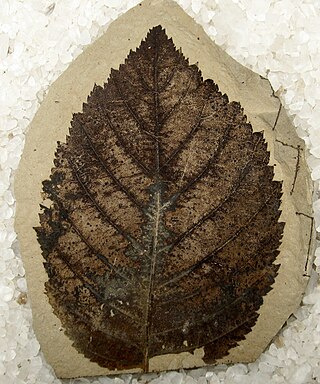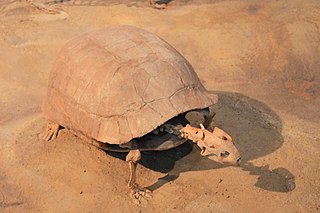
The Gruiformes are an order containing a considerable number of living and extinct bird families, with a widespread geographical diversity. Gruiform means "crane-like".

Paleobotany, also spelled as palaeobotany, is the branch of botany dealing with the recovery and identification of plant remains from geological contexts, and their use for the biological reconstruction of past environments (paleogeography), and the evolutionary history of plants, with a bearing upon the evolution of life in general. A synonym is paleophytology. It is a component of paleontology and paleobiology. The prefix palaeo- or paleo- means "ancient, old", and is derived from the Greek adjective παλαιός, palaios. Paleobotany includes the study of terrestrial plant fossils, as well as the study of prehistoric marine photoautotrophs, such as photosynthetic algae, seaweeds or kelp. A closely related field is palynology, which is the study of fossilized and extant spores and pollen.

Ground squirrels are rodents of the squirrel family (Sciuridae) that generally live on the ground or in burrows, rather than in trees like the tree squirrels. The term is most often used for the medium-sized ground squirrels, as the larger ones are more commonly known as marmots or prairie dogs, while the smaller and less bushy-tailed ground squirrels tend to be known as chipmunks.

Homo is a genus of great ape that emerged from the genus Australopithecus and encompasses only a single extant species, Homo sapiens, along with a number of extinct species classified as either ancestral or closely related to modern humans; these include Homo erectus and Homo neanderthalensis. The oldest member of the genus is Homo habilis, with records of just over 2 million years ago. Homo, together with the genus Paranthropus, is probably most closely related to the species Australopithecus africanus within Australopithecus. The closest living relatives of Homo are of the genus Pan, with the ancestors of Pan and Homo estimated to have diverged around 5.7-11 million years ago during the Late Miocene.

Ostriches are large flightless birds. Two living species are recognised, the common ostrich, native to large areas of sub-Saharan Africa, and the Somali ostrich, native to the Horn of Africa.

The Syngnathidae is a family of fish which includes seahorses, pipefishes, and seadragons. The name is derived from Ancient Greek: σύν, meaning "together", and γνάθος, meaning "jaw". The fused jaw is one of the traits that the entire family have in common.

Lontra is a genus of otters from the Americas.

Condylura is a genus of moles that contains a single extant species, the star-nosed mole (Condylura cristata) endemic to the northern parts of North America. It is also the only living member of the tribe Condylurini.

Neurotrichus is a genus of shrew-like moles. It is classified, together with the fossil genus Quyania, in the tribe Neurotrichini of the subfamily Talpinae. The only living species is the American shrew-mole (N. gibbsii) of the northwestern United States and British Columbia. A fossil species, Neurotrichus columbianus from the Hemphillian of Oregon, was placed in the genus in 1968, but this animal is now thought to be more closely related to the Chinese fossil genus Yanshuella.

The Carangidae are a family of ray-finned fish that includes the jacks, pompanos, jack mackerels, runners, trevallies, and scads. It is the largest of the six families included within the order Carangiformes. Some authorities classify it as the only family within that order but molecular and anatomical studies indicate that there is a close relationship between this family and the five former Perciform families which make up the Carangiformes.

Acacia, commonly known as wattles or acacias, is a genus of about 1,084 species of shrubs and trees in the subfamily Mimosoideae of the pea family Fabaceae. Initially, it comprised a group of plant species native to Africa, South America, and Australasia, but is now reserved for species mainly from Australia, with others from New Guinea, Southeast Asia, and the Indian Ocean. The genus name is Neo-Latin, borrowed from the Greek ἀκακία, a term used in antiquity to describe a preparation extracted from Vachellia nilotica, the original type species.
Dinodocus is a genus of sauropod dinosaur, named by Richard Owen in 1884. The name is now usually considered a nomen dubium. The only species, D. mackesoni, a name given to some fossil bones from the Lower Greensand Group of Hythe, Kent, England, were formerly placed in the genus Pelorosaurus, but a review by Upchurch et al. (2004) concluded that Dinodocus is a nomen dubium.

Clemmys is a genus of turtles currently containing a single extant species, the spotted turtle (Clemmys guttata).

Elseya is a genus of large side-necked turtles, commonly known as Australian snapping turtles, in the family Chelidae. Species in the genus Elseya are found in river systems in northern and northeastern Australia and throughout the river systems of New Guinea. They are identified by the presence of alveolar ridges on the triturating surfaces of the mouth and the presence of a complex bridge strut.

Ginkgo is a genus of non-flowering seed plants, assigned to the gymnosperms. The scientific name is also used as the English common name. The order to which the genus belongs, Ginkgoales, first appeared in the Permian, 270 million years ago, and Ginkgo is now the only living genus within the order. The rate of evolution within the genus has been slow, and almost all its species had become extinct by the end of the Pliocene. The sole surviving species, Ginkgo biloba, is found in the wild only in China, but is cultivated around the world. The relationships between ginkgos and other groups of plants are not fully resolved.

Stylemys is the first fossil genus of dry land tortoise belonging to the order Testudines discovered in the United States. The genus lived in temperate to subtropical areas of North America, Europe, and Asia, based on fossil distribution. The genus was first described in 1851 by Joseph Leidy. The tortoise was common in the prehistoric Badlands, especially Nebraska and South Dakota. The species has also been found in the formations in and around Badlands National Park. Fossil fragments have also been found in the Palm Park Formation of New Mexico.
Caririemys is an extinct genus of side-necked turtles, belonging to the Pelomedusoides of the family Euraxemydidae. The type species is C. violetae. A single fossil of an individual was found in the Santana Formation in Brazil, an 80-million-year-old Late Cretaceous deposit that has so far preserved other fossil reptiles such as dinosaurs and crocodilians.
Tacuarembemys is an extinct genus of continental turtle from South America. It contains a single species, T. kusterae. The genus was described based on the external mold of a carapace and associated shell bone fragments found near the city of Tacuarembó, Uruguay. This fossil was found on the Tacuarembó Formation, whose estimated age ranges from late Jurassic to earliest Cretaceous.















